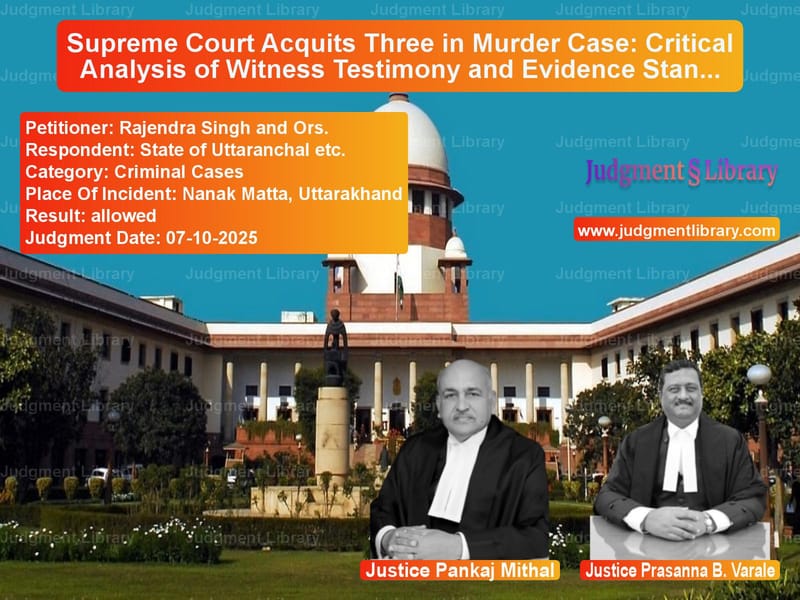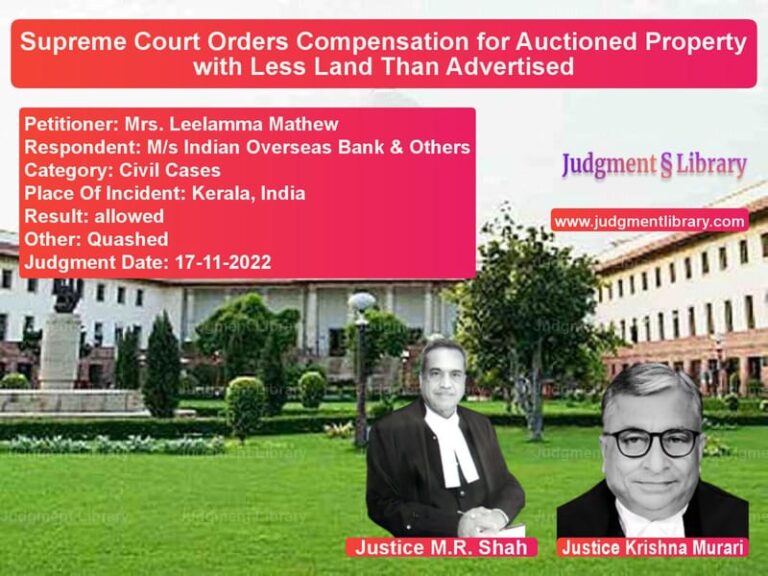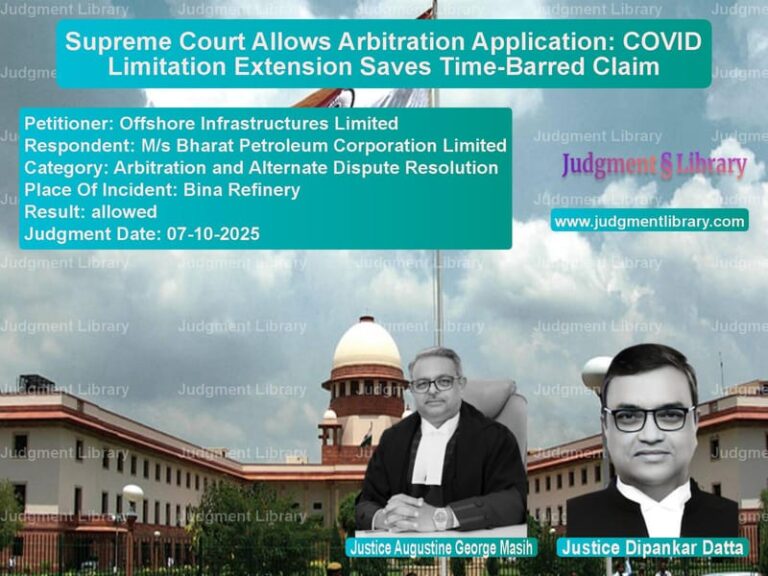Supreme Court Acquits Three in Murder Case: Critical Analysis of Witness Testimony and Evidence Standards
In a significant judgment that underscores the importance of reliable evidence and proper identification procedures in criminal cases, the Supreme Court has acquitted three men who were convicted for a murder that occurred over two decades ago. The case involving Rajendra Singh, his son Bhupender Singh, and son-in-law Ranjeet Singh highlights the critical legal principles that govern criminal trials, particularly when dealing with eyewitness testimony and recovery of evidence.
The tragic incident dates back to June 3, 2000, when Pushpendra Singh, son of Diler Singh, was brutally murdered. The prosecution’s case was that on the morning of the fateful day, Rajendra Singh and his son Bhupender Singh had a quarrel with Diler Singh when they started digging his field for laying down a plinth. This altercation allegedly provided the motive for the subsequent attack on Pushpendra Singh later that day.
The Prosecution’s Version of Events
According to the prosecution, at about 1:30 PM on the same day, when Pushpendra Singh was sitting at Jogither diversion, his father Diler Singh, while returning from a flour mill accompanied by his brother-in-law Papender Singh, saw the three appellants arriving on a motorcycle driven by Ranjeet Singh. The prosecution claimed that the appellants parked their vehicle, exhorted the deceased, and then chased him as he started running toward northern fields while raising alarms.
The prosecution alleged that Diler Singh, Papender Singh, and some other persons including Jwala Singh started running behind the accused to save Pushpendra Singh. The deceased, in an attempt to save his life, entered the house of one Mukhtyar Singh. The appellants allegedly followed him inside and inflicted blows with swords and a kanta (sharp-edged weapon), resulting in his immediate death on the spot.
Diler Singh lodged an FIR the same day at 2:50 PM at Police Station Nanak Matta under Section 302 of IPC. The investigation followed with panchnama preparation, witness statements recording, site plan preparation, and post-mortem examination. The appellants were arrested between June 5-7, 2000, and weapons were recovered based on their disclosures.
The Legal Journey Through Courts
The case took a dramatic turn as it moved through different judicial forums. The Trial Court initially acquitted all three accused, but the High Court reversed this decision and convicted them under Section 302 IPC with life imprisonment and a fine of Rs. 10,000 each. The High Court’s judgment dated January 2, 2013, set the stage for the final legal battle before the Supreme Court.
Before the Supreme Court, the appellants’ counsel advanced several crucial arguments. The primary submission was that “they have been falsely implicated. There is no reliable evidence to establish the identity of the appellants as the alleged assailants. There is no eyewitness to the incident, except the lady of the house into which the deceased had entered to save his life.” The counsel also highlighted that “there are large contradictions in the statements of the witnesses and that the discovery of the weapons of crime is false and otherwise also has no relevance to establish the identity of the accused with that of the assailants.”
The State’s Defense
The State counsel strongly opposed the appellants’ submissions, arguing that “all the three accused were seen by the witnesses chasing the deceased, who had entered the house of Mukhtyar Singh, and assaulted him with the swords and the kanta which fact was witnessed by the lady of the house, Amarjeet Kaur (PW-7).” The State emphasized that “the clothes of PW-7 which had blood stains were sealed by the police and the FSL report confirmed the presence of blood on the clothes.”
Regarding the recovered weapons, the State counsel submitted that “on the disclosure of the appellants, the weapons of crime were recovered, and they admitted to having committed the crime with the same. The above evidence leaves no scope for doubt about the commission of the offence at the hands of the appellants.” The State maintained that “the High Court rightly reversed the decision of acquittal recorded by the Trial Court, so as to convict the appellants for the offence under Section 302 of IPC and sentenced them to life imprisonment.”
The Supreme Court’s Critical Analysis
The Supreme Court conducted a meticulous examination of the evidence, particularly focusing on the testimony of key witnesses and the recovery of weapons. The Court noted that while the morning altercation could provide a motive, “that by itself would not be sufficient to rope in the appellants unless their involvement in the offence is established by cogent evidence.”
The Court carefully analyzed the testimony of Amarjeet Kaur (PW-7), the lady of the house where the murder occurred. The Court observed that “the said witness, who is the wife of Mukhtyar Singh, the owner of the house, clearly deposed that the three accused persons killed the boy in the house. They entered carrying swords and other weapons in their hands.” However, the Court crucially noted that “she categorically stated that she did not know the name of the accused persons.”
This became a pivotal point in the judgment, as the Court emphasized that “no identification parade was carried out and PW-7 was not even asked to confirm whether the appellants were the accused persons. The police failed to get the appellants identified by her. Therefore, it is doubtful whether the persons who assaulted the deceased were actually the appellants.”
Contradictions in Witness Testimonies
The Court identified significant contradictions between the testimonies of PW-7 and PW-1 (Diler Singh, the victim’s father). While PW-7 stated that the father and other persons arrived about half an hour after the incident, PW-1 claimed to have witnessed the actual assault. The Court found that “the testimony of PW-7 is apparently quite trustworthy as there is no reason to disbelieve it. It is clear from her statement that PW-1 had reached the place of incident after half an hour of the incident. He is, therefore, not actually an eyewitness who was present at the time when the appellants allegedly attacked the deceased.”
The Court also questioned the naturalness of PW-1’s conduct, noting that “he never offered his blood-stained clothes to the police for investigation, nor did the police seized the same, despite the fact that he had gone to the police station wearing them. Rather, he stated that he washed them and wore them again. This is quite unnatural and an indicator to the fact that the PW-1 was not actually present when the incident of assault took place.”
Regarding PW-2 Jwala Singh, the Court classified him as “a chance witness” and noted that “his entry in the house of Mukhtyar Singh would have been only after PW-1, who had entered the house as per the ocular evidence of PW-7, about half an hour after the incident.”
The Issue of Weapon Recovery
The Court delivered a significant ruling on the evidentiary value of weapon recovery. While the prosecution relied on the recovery of swords and kanta based on the appellants’ disclosures, the Court noted that “no effort was made to match the blood on the said weapons with that of the deceased. The weapons were sent for forensic examination but no report of the forensic laboratory was produced to establish that the weapons so recovered were smeared with the blood of the deceased.”
The Court provided a detailed analysis of Sections 25, 26, and 27 of the Indian Evidence Act, explaining that “only that part of the statement which leads the police to the recovery of the weapons is admissible, and not the part which alleges that the weapons recovered were actually the weapons of crime.”
Citing the landmark case of Pulukuri Kottaya and Ors. vs. The King Emperor, the Court elaborated that “information supplied by a person in custody such as ‘I will produce a knife concealed in the roof of my house’, only leads to the discovery of the knife concealed in the house of the informant, but whether the knife is proved to have been used in the commission of an offence is another question.” The Court further clarified that “if the above information is followed by the words, ‘with which I stabbed A’, those words would be inadmissible since they do not relate to the discovery of the knife from the house of the informant, but are rather independent in nature, amounting to confession of the crime.”
The Final Ruling and Acquittal
In its conclusive findings, the Supreme Court held that “the identity of the appellants as the persons involved in the offence has not been established either by any ocular evidence or from the recovery of the weapons of crime.” The Court emphasized the importance of the presumption of innocence and the high standard of proof required in criminal cases.
The Court also criticized the High Court’s approach in reversing the Trial Court’s acquittal, noting that “the order of acquittal passed by the Trial Court was not open to interference by the First Appellate Court until and unless the findings recorded by the Trial Court were per se perverse or erroneous. It is safer and more appropriate to rely upon the findings of the Trial Court which has seen the demeanor of the witnesses rather than to rely upon the findings of the First Appellate Court.”
The Supreme Court concluded that “the High Court manifestly erred in interfering with the findings of acquittal recorded by the Trial Court and reversing the judgment so as to convict the appellants. It is doubtful whether the offence has been committed by the appellants.” Accordingly, the Court allowed the appeals and acquitted all three appellants, granting them the benefit of doubt.
This judgment reinforces several fundamental principles of criminal jurisprudence: the importance of reliable identification evidence, the limitations of recovery evidence under the Evidence Act, the cautious approach required when dealing with chance witnesses, and the high threshold for appellate courts to reverse acquittals. The decision serves as a reminder that in criminal law, it is better that ten guilty persons escape than one innocent suffer.
Petitioner Name: Rajendra Singh and Ors..Respondent Name: State of Uttaranchal etc..Judgment By: Justice Pankaj Mithal, Justice Prasanna B. Varale.Place Of Incident: Nanak Matta, Uttarakhand.Judgment Date: 07-10-2025.Result: allowed.
Don’t miss out on the full details! Download the complete judgment in PDF format below and gain valuable insights instantly!
Download Judgment: rajendra-singh-and-o-vs-state-of-uttaranchal-supreme-court-of-india-judgment-dated-07-10-2025.pdf
Directly Download Judgment: Directly download this Judgment
See all petitions in Murder Cases
See all petitions in Evidence Law
See all petitions in Judgment by Pankaj Mithal
See all petitions in Judgment by Prasanna Bhalachandra Varale
See all petitions in allowed
See all petitions in supreme court of India judgments October 2025
See all petitions in 2025 judgments
See all posts in Criminal Cases Category
See all allowed petitions in Criminal Cases Category
See all Dismissed petitions in Criminal Cases Category
See all partially allowed petitions in Criminal Cases Category







